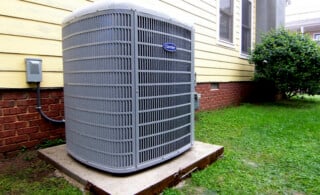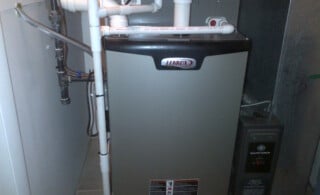
Excellent question. The answer is yes. A whole-house humidifier is a smart addition to any home. They help reduce air borne allergens, decrease your chance of catching common colds and flu in winter, and extend the life of your home furnishings, hardwood flooring, and just about everything else in your home by keeping the air in your home at the ideal humidity level of 35-50%.
Whole-House Humidifier Types
Every whole-house humidifier works the same in that they are installed directly into your present central heating and air conditioning system. They regulate the overall humidity in your home, and automatically add moisture to the system when your furnace or air conditioner kicks on. They differ only in how they introduce that moisture to the system. The three most common types are drum, flow-through, and spray mist humidifiers.
- Drum Systems have a foam or fabric belt that spins on a drum over a water reservoir. The belt wicks moisture from the reservoir, and when the furnace or A/C blows air over the drum, the moisture evaporates into the air and is carried into your home. Drum systems are the cheapest of the three, but they must be cleaned periodically. Failure to do so can lead to mold growth in the water reservoir.
- Flow Through Systems operate by dripping water through a foam or aluminum pad. Your furnace or A/C blows air through the pad, picking up moisture and delivering it to the rest of your home. Flow through systems don’t have the problems with mold that drum systems have, though you will need to clean or replace the pad periodically since it will eventually accumulate dust and dirt and clog up. You’ll also need a floor drain or a receptacle to catch drain water, since any extra water that accumulates in the pad flows out of the unit through a simple drain hose.
- Spray Mist Systems spray a fine mist into your ductwork when your furnace or A/C kicks on. They don’t require the regular maintenance of drum or flow-through systems, though they can clog up with mineral deposits if your well or municipal water supply has hard water.
Whole-House Humidifier Installation
Once you’ve chosen the type of humidifier for you home, it’s time to start thinking about installation. To start with, check to make sure that the area where you plan to install your humidifier never drops below freezing during wintertime. A/C units and furnaces are often installed in basements and attics, meaning there is the possibility (especially in the attic) that the mercury could drop below freezing during winter months. Freezing temperatures and humidifiers don’t mix because freezing water causes seals, pipes, and joints to fail. Other than checking against low temperatures, it’s also important that you buy the correct sized unit for your home. That means figuring out the cubic footage of your home (length x width x height), and then looking for a whole-house humidifier that meets those needs.
Call a Contractor
Your best bet for proper installation and sizing is to contact an HVAC contractor about coming in to do the work for you. They’ll be able to determine how large of unit you’ll need, which model will work best for you, and where it’s best to install it.
 Air Conditioner Condenser Coil Costs, Repairs & Replacements
Air Conditioner Condenser Coil Costs, Repairs & Replacements  Ceiling Fan Installation
Ceiling Fan Installation  Consider Wood-Burning Furnaces
Consider Wood-Burning Furnaces  Outdoor Heaters: a Refuge from the Cold
Outdoor Heaters: a Refuge from the Cold  Can You Delay Replacement when the Furnace Breaks? Maybe…
Can You Delay Replacement when the Furnace Breaks? Maybe… 

Are You Familiar With This Topic? Share Your Experience.